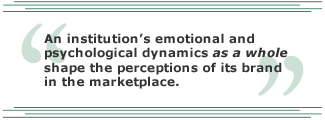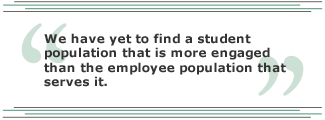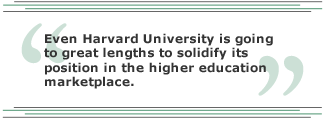Do these workers sound familiar to you?
- Dana works in the marketing department, and his primary goal is increasing his organization's conversion rate. His challenge is that everybody he works with seems to have a different opinion about how to achieve that objective.
- Maryellen is on a steering committee that is actively pushing a strategic quality improvement initiative to strengthen the organization's culture and brand. She has the same challenge that Dana does, but with bigger egos involved.
- George is the organization's president. His current focus is on creating a sense of shared mission, vision, and strategy in an organization characterized by empire building within various departments.
What's more, Dana, Maryellen, and George are passionately committed to meeting their goals because their initiatives are at the core of the organization's strategic branding efforts.
Maybe you've met Dana, Maryellen, and George. You probably work with people just like them; all three have roles that could be found in any corporation. But they don't work in one. Dana, Maryellen, and George are leaders in academe.
 |
The reason that Dana, Maryellen, and George seem so familiar is because academe and the corporate world share many characteristics. Prospective students, like prospective customers, have a vast array of choices: private or public school, large or small, domestic or international, liberal arts or technical -- the list goes on. Like businesses competing for talented workers, colleges and universities compete vigorously for talented students and calculate ways to improve the conversion rate from accepted to enrolled student. Higher education is a broad marketplace, and no college or university can rest on its laurels.
Calls for change and improvement
Competition for students isn't the only worry for academic professionals. Scholarly commissions and blue-ribbon panels have called for widespread improvements in accountability and transparency. For example, a Kellogg Commission report outlined a seven-part test of institutional engagement, which the commission proposed as a necessary condition for improving higher education.
Another commission appointed by U.S. Education Secretary Margaret Spellings reported: "Among the vast and varied institutions that make up U.S. higher education, we have found much to applaud but also much that requires urgent reform. . . . As other nations rapidly improve their higher education systems, we are disturbed by evidence that the quality of student learning at U.S. colleges and universities is inadequate and, in some cases, declining."
A commentary by Larry Braskamp and Steven Schomberg on the Spellings Commission report lays out basic demands being made of leaders in higher education: "For confidence, trust, and satisfaction to occur, higher education . . . must first recognize that public accountability is a fact and an appropriate expectation. . . . A second step is for higher education to make transparent the evidence of quality that the public needs in order to trust higher education. We must measure what is meaningful, not give meaning to what we measure. . . . Assessment should be informing the various publics about how the educational experiences of students or of the institutional engagement in the larger society is bringing value to the students and society."
As Alec Gallup, chairman of The 优蜜传媒Poll, put it: "Dramatic institutional change can occur only by capturing the hearts, minds, and souls of all those individuals who comprise the academic community. Engagement, ownership, trust, confidence, integrity, passion, and well-being are some of the key ingredients to fostering an interconnected, collaborative, and efficient institution."
It's about the brand
Business leaders frequently obsess about their company's brand image; leaders in higher education likewise fixate on their school's perceived image and value equation in the marketplace. In many cases, though, educational brand strategy is limited to marketing and advertising campaigns. But an effective brand management strategy can be maximized only if the brand carries a promise -- and if every member of the academic community is committed to fulfilling that promise.
The challenge of building an educational brand is compounded by collegiate ranking methodologies, which make institutions' value propositions blatant, though not necessarily accurate. Several presidents have publicly refused to participate in ranking surveys, and others will elect to do the same. But most won't. Leadership teams often decry the flaws in collegiate rankings while continuing to participate in the process, thus adding to the misalignment of academic perceptions and brands.
Though some might consider the notion of running a university like a business to be somewhat crass, the challenge of building a brand is ultimately the same for both.
Market perceptions
Academics and the student experience are foundational elements of any higher education institution and are key elements of its brand promise. Institutions that want to actively manage their education brand must first consider how the marketplace perceives their brand promise. When comparing educational brands, some institutions are leading marketplace perceptions, while others are lagging.
 |
For example, the 2006 TIME magazine article "Who Needs Harvard?" observed: "There are scores . . . hundreds even, [of] honors colleges embedded inside public universities that offer an Ivy education at state-school prices; small liberal-arts colleges that exalt the undergraduate experience in a way that the big schools can't rival."
In other words, some institutions are delivering student experiences that exceed the market's perceptions, while others -- which may have higher traditional prestige -- offer student experiences that deliver nothing more than market perceptions would suggest, and sometimes less. Over time, marketplaces have a way of correcting themselves, and innovative leaders will capitalize on the changing times. One of the biggest challenges for leaders is to get everyone in the organization to unite behind the brand strategy.
Brand strategies
Factors such as academic offerings, student experience, an institution's prestige, and "intangibles" comprise a higher education brand promise. And prospective students are hyperaware of the numerous brand images in higher education. Abundant online tools, publications, and other resources make today's college students better informed and more cognizant of available options than ever before.
Some prospective students are looking past the famous schools' brand promise and buying into the brands of other institutions. These days, virtually all students are brand shoppers -- but not all colleges have developed effective brand strategies.
Ironically, colleges and universities that have granted degrees in branding and brand management for decades haven't made brand management strategy a core function of their senior leadership. Much of the branding work in higher education has been in peripheral areas, such as assessing Pantone colors in logos, creating and disseminating marketing materials, or selling licensed merchandise.
One branding consultant wrote in his blog: "Florida Atlantic University is getting branded. They've got feedback from 1,500 people, and they are deciding on colors . . . and mascots . . . and this only took 16 focus groups and 200 opinions on ways to improve the colors and logos. What's missing in this story? Any mention of the quality of education or customer experience."
The blogger's comments ridicule a dangerously narrow view of branding that's rampant in academe. Many of the challenges that higher education leaders face are brand-related: student recruiting and admissions, alumni giving, community relations, faculty engagement, staff culture, and the student experience. In essence, the emotional and psychological dynamics of an educational institution as a whole influence and shape the perceptions of its brand in the marketplace. The brand image of an institution is created by and reflects all those institutional dynamics.
Another ironic example is that many Ivy League schools have graduation rates as high as 98%, and students will remain even though the student experience may be better at less expensive public institutions with much lower graduation rates. This dynamic is a result of the power of branding.
Given the needs of the market and its customers, 优蜜传媒researchers see a demand for innovative leaders who can take the best business principles and apply them to the best academic traditions. These leaders will help higher education preserve its heritage while creating a new legacy by changing the face of academe.
Specifically, these leaders will do two things:
- update curricula to reflect the needs of the changing marketplace dynamics of the student population and the impact of globalization
- improve the engagement levels and operational effectiveness of the institution to enhance the student experience and maximize the return on dollars invested
Updated curricula
The business community recognizes that globalization is both inescapable and a golden opportunity. Because higher education prepares students to enter this business climate -- and because higher education should be responsive to the same global market forces that affect business -- curricula must be relevant in today's global marketplace.
Too many academics assume that globalization is only an issue for the business and modern language departments. That's a mistake. For example, in its report on "College Learning for the New Global Century," the Association of American Colleges and Universities concluded: "The context in which today's students will make choices and compose lives is one of disruption rather than certainty, and of interdependence rather than insularity. . . . Reflecting the traditions of American higher education since the founding, the term 'liberal education' headlines the kinds of learning needed for a free society and for the full development of human talent."
 |
The effects of globalization require not only new academic subjects, but they also present fresh avenues of pedagogy. Institutions must accommodate nontraditional students, an aging student population, more online and distance learning, and a broader spectrum of student needs. Colleges and universities that manage these changes successfully will strengthen their brand's position in the marketplace.
Brand experience, though, is another matter. An institution's brand experience is the result of human interactions that boost students' and employees' emotional engagement -- or diminish it. Educational leaders must play a key role in engaging students and the institution's faculty and staff. We have yet to find a student population that is more engaged than the employee population that serves it.
Engagement
In higher education, student engagement depends largely on creating a sense of belonging. Feeling as though they are a part of a larger community is a critical aspect of a student's choice to remain connected to that community. This sense of belonging hinges on the interactions students have and the relationships they build -- not just with fellow students, but with faculty, staff, and administrators. Thus, all these groups -- staff, faculty, administrators, and even the students themselves -- play key roles in delivering an institution's brand promise.
The choice to stay enrolled in school is heavily influenced by student engagement. And levels of student engagement correlate strongly to many of the outcomes institutions care about: retention, graduation rates, achievement gains, and alumni giving. For example, a study of Stanford University alumni stated that "Satisfaction with the undergraduate experience is the single most essential pre-condition for giving. . . . Those who are not satisfied are, without exception, nondonors."
The same study concluded: "Alumni who are made to feel that they are still an important part of the Stanford community are much more likely to be donors than those who do not feel they are an important part of the Stanford community. . . . Those who most value their Stanford education want to be donors, while others must be convinced."
Accept the best
Harvard University is regarded by many as one of the best educational institutions in America, and possibly in the world. It's certainly one of the richest, with an endowment nearing $30 billion. So it's easy to assume that Harvard could disband its recruiting, development, and marketing departments and still do well, coasting on its unassailable brand image and brand promise.
But Harvard doesn't think so. The university is going to great lengths to solidify its position in the higher education marketplace. Drew Gilpin Faust, Ph.D., was selected to lead the university because, among other qualities, she's an exceptional consensus builder. Harvard is revamping its curriculum for the first time in a generation and focusing more on a global perspective. Furthermore, Harvard is actively working to unify its 11 notoriously independent colleges.
In other words, Harvard is updating its academic offerings to reflect a changing world, and its new president is working to create a collective sense of engagement through a shared sense of mission. The one school that seems to face the least competitive threat is going to great lengths to do what we think all schools must do -- build a stronger brand.
"Build a stronger brand" is easy to say. But delivery is another matter. The brand promise is based on academics and emotional engagement, and engagement derives partly from the institution's leadership. All of these issues are critically important, and all are severely devalued if the brand promise is fragmented or delivered poorly.
Effective delivery requires that an institution's leaders have a clear understanding of the marketplace's perceptions of its brand; that its staff, administration, and faculty cohesively execute the brand strategy; and that it actively pursues student and employee engagement.
|
Further Reading Association of American Colleges and Universities, National Leadership Council for Liberal Education and America's Promise. (2007). College Learning for the New Global Century. Available from . Braskamp, L. & Schomberg, S. (2006, July 26). Caring or uncaring assessment. Retrieved July 2, 2007, from . Gibbs, N. & Thornburgh, N. (2006, Aug. 13). Who needs Harvard? TIME. Retrieved July 2, 2007, from . Kellogg Commission on the Future of State and Land-Grant Universities. (2001). Returning to Our Roots: Executive Summaries of the Reports of the Kellogg Commission on the Future of State and Land-Grant Universities. Available from . Stanford University News Service. (1994, December 13). Survey looks at factors that affect alumni giving. Retrieved July 2, 2007, from . U.S. Department of Education, The Secretary of Education's Commission on the Future of Higher Education. (2006). A Test of Leadership: Charting the Future of U.S. Higher Education. Available from . Young, D. (2004, July 31). University branding by committee. Retrieved July 2, 2007, from . |